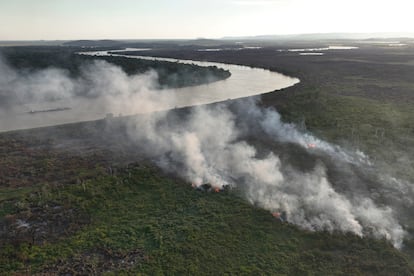Conditions behind devastating fires in the Pantanal region of South America were intensified by climate change
If global warming continues, such events could repeat themselves every 17 years according to a recent study published by World Weather Attribution


Brazil has recently experienced a series of extreme weather events. In October of 2023, its Amazon region experienced a historic drought. And, in May of this year, floods in the state of Rio Grande do Sul caused unprecedented devastation.
Although it received less publicity, this June the Pantanal — the largest tropical wetland in the world and a hotbed of biodiversity — went up in flames. In that month alone, it’s estimated that 440,000 hectares were burned, an unusual figure if one takes into account that the forest fire season in this ecosystem doesn’t typically begin until July, while its peak occurs in August and September.
As happened in the first two cases, everything indicates that climate change also played an important role in these fires, which have so far burned more than 1.2 million hectares, or 8% of this biome, in Brazil. This is equivalent to half the size of Belgium.
“Human-induced climate change has increased the conditions favorable to fires — such as heat, dryness and wind — by 40%,” warns a study by World Weather Attribution (WWA), an organization made up of scientists seeking to determine exactly what influence climate change has had following the occurrence of an extreme weather event. While their research isn’t peer-reviewed, the methodologies they use are, which allows them to shed light on what happened in record time.

Thanks to current climate change — as the document also points out — the probability of these fires occurring in the Pantanal region is four to five times greater. Meanwhile, their impact is three times worse and they’re expected to occur at least every 35 years.
“In 2024, the lowest historical levels of water in the region’s rivers have been recorded,” explained Filippe L. M. Santos, co-author of the research and a scientist at the University of Évora, in Portugal, during a press conference. “This — added to the high temperatures and low rainfall—– created the perfect conditions for a disaster of this proportion.”
While other factors play a role in the spread of fires, such as the type of vegetation, fire management and land use change, the WWA study specifically focused on how climate change influences the meteorological conditions that benefit the spread of flames, not on the forest fires themselves. But even so, the study concluded that, if the Earth’s temperature rises by 2°C by the end of the century when compared to the pre-industrial era, such fires will be twice as likely to occur in June in the Pantanal, recurring “about once every 17 years, [while becoming] 17% more impactful.”

It’s worth remembering that the Paris Agreement seeks to limit the increase in temperature to 2°C, while “striving” to ensure that the increase is only 1.5°C. Thus, what this type of analysis reveals is that, even if the goal is met, the consequences of climate change will be drastic.
“As fossil fuel emissions warm the climate, the wetland is heating up, drying out and turning into a tinderbox. This means small fires can rapidly accelerate into devastating ones, regardless of how they’re started,” says Clair Barnes, a researcher at the Grantham Institute of Imperial College London and co-author of the document from WWA.
To obtain this data, the team analyzed the historical behavior of variables such as maximum temperature, relative humidity, wind speed, and rainfall in the Pantanal. They then cross-referenced this information with climate models, which reveal how these elements have been altered by the increase in the average temperature of the Earth. The result, the scientists note, wasn’t so unexpected: since June of 2024, almost all of these variables — except relative humidity — have surpassed previous records.
What’s also worrying is that the Pantanal is still on fire. And, as Barnes pointed out, if June — which isn’t usually part of forest fire season — was so drastic, “a similar trend is expected for [subsequent] months.” July seemed to provide a bit of respite, but so far in August, there are already various alerts. By August 6, 536 hot spots were recorded out of a total of 1,899 that have been identified so far this month.

Sign up for our weekly newsletter to get more English-language news coverage from EL PAÍS USA Edition
Tu suscripción se está usando en otro dispositivo
¿Quieres añadir otro usuario a tu suscripción?
Si continúas leyendo en este dispositivo, no se podrá leer en el otro.
FlechaTu suscripción se está usando en otro dispositivo y solo puedes acceder a EL PAÍS desde un dispositivo a la vez.
Si quieres compartir tu cuenta, cambia tu suscripción a la modalidad Premium, así podrás añadir otro usuario. Cada uno accederá con su propia cuenta de email, lo que os permitirá personalizar vuestra experiencia en EL PAÍS.
¿Tienes una suscripción de empresa? Accede aquí para contratar más cuentas.
En el caso de no saber quién está usando tu cuenta, te recomendamos cambiar tu contraseña aquí.
Si decides continuar compartiendo tu cuenta, este mensaje se mostrará en tu dispositivo y en el de la otra persona que está usando tu cuenta de forma indefinida, afectando a tu experiencia de lectura. Puedes consultar aquí los términos y condiciones de la suscripción digital.
More information
Archived In
Últimas noticias
Most viewed
- Sinaloa Cartel war is taking its toll on Los Chapitos
- Oona Chaplin: ‘I told James Cameron that I was living in a treehouse and starting a permaculture project with a friend’
- Reinhard Genzel, Nobel laureate in physics: ‘One-minute videos will never give you the truth’
- Why the price of coffee has skyrocketed: from Brazilian plantations to specialty coffee houses
- Silver prices are going crazy: This is what’s fueling the rally










































